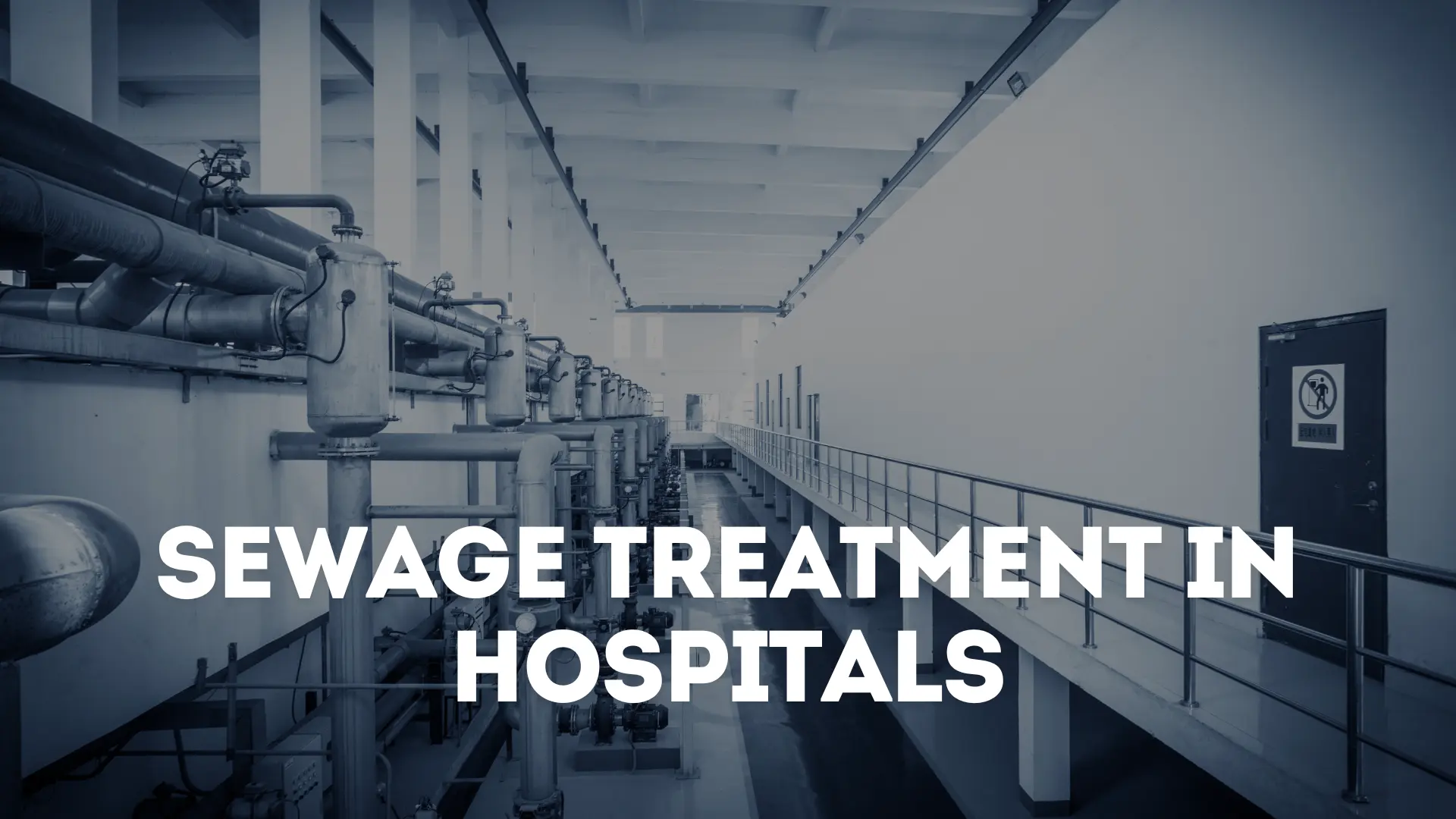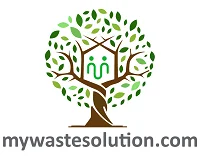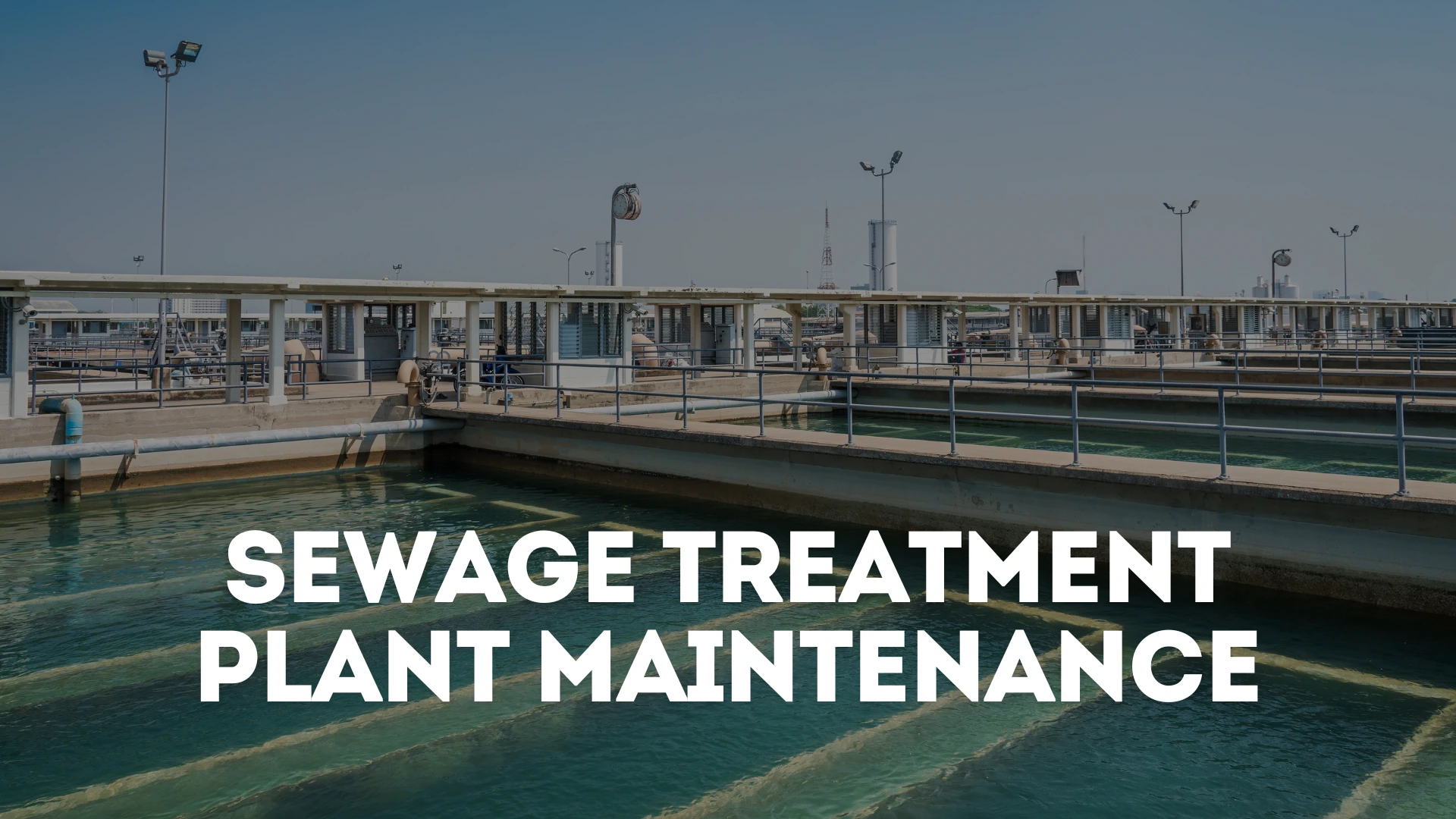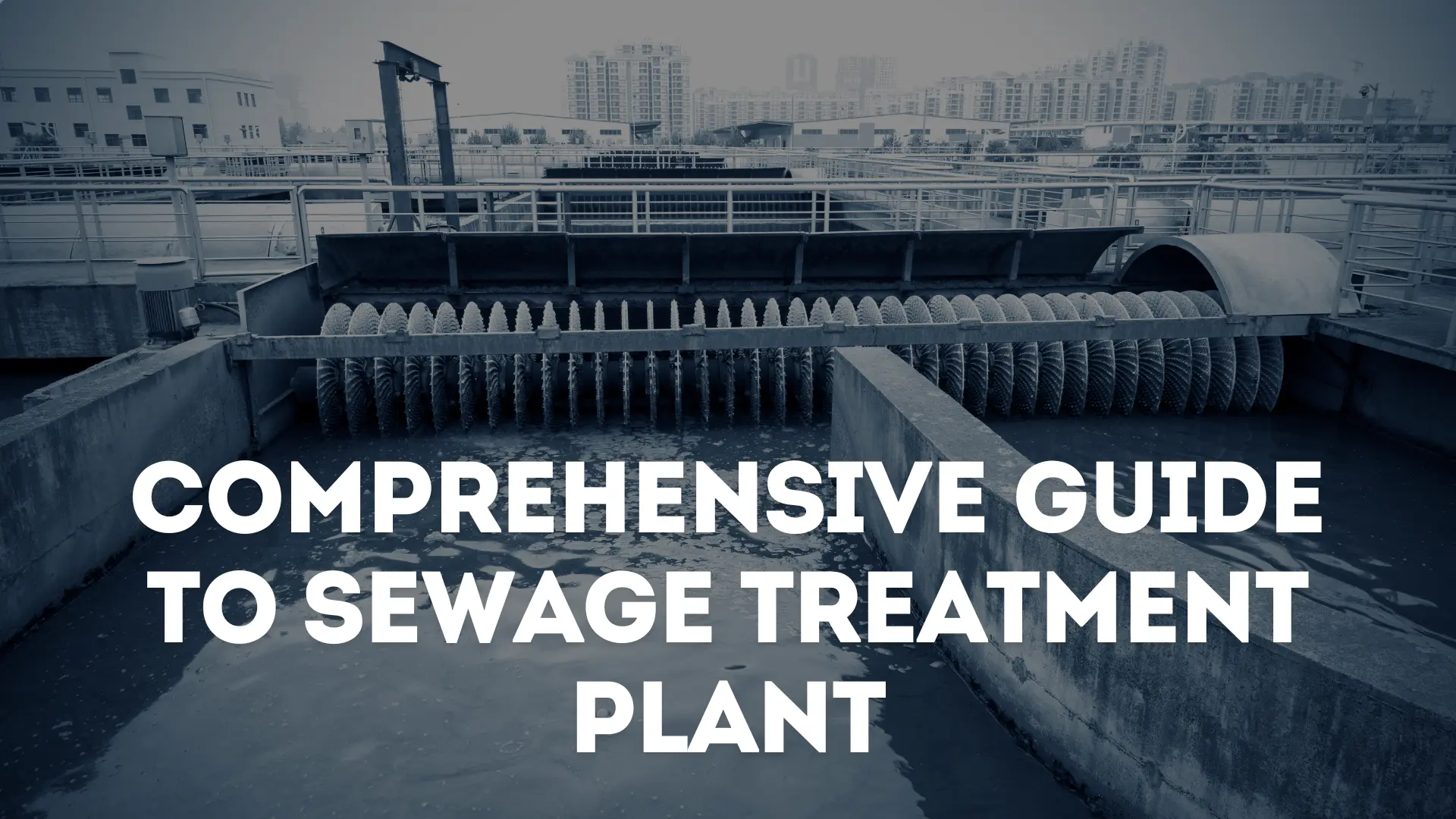Sewage Treatment Plant for Hospitals plays a vital role in safeguarding public health and supporting medical advancements. Hospitals use various chemicals for accurate diagnoses, effective treatments, and thorough sanitation (Mike and Rai, 2018). However, hospital wastewater often contains emerging contaminants, including pharmaceutically active compounds (PhACs), antibiotic-resistant bacteria (ARB), antibiotic-resistant genes (ARGs), and persistent viruses, which pose significant environmental and health risks (Kwak et al., 2015; Nielsen et al., 2013; Lien et al., 2016; Dires et al., 2018).
1. The Vital Role of Sewage Treatment Plant for Hospitals
If left untreated, hospital wastewater can contaminate water sources, posing significant risks to public health and contributing to environmental degradation. Efficient sewage treatment in hospitals is crucial for mitigating these threats and preserving both human health and ecological balance. Proper wastewater treatment in medical facilities includes the collection, filtration, and responsible disposal of contaminants to protect individuals and ecosystems (Ibiam and Igewnyi, 2012). Investing in advanced Sewage Treatment Plants for Hospitals is essential for safeguarding communities and promoting a cleaner, more sustainable future.
1.1. Protecting Health and Environment with Hospital Sewage
India’s healthcare sector generates approximately 3 million tons of medical waste annually, with an 8% increase each year (Mohankumar and Kottaiveeran, 2010). Improper management of this waste poses significant risks to public health and the environment. Studies reveal that many hospitals discharge untreated pharmaceuticals, including antibiotics and resistant genes, into water systems (Celic, Preeti, Astha, 2019, 2009, 2020). These contaminants in surface water, soil, and sediments threaten human health and environmental stability (Macarena, Emmanuel, 2014, 2004). Effective wastewater treatment in hospitals, particularly through a Sewage Treatment Plant for Hospitals, is essential to mitigate these risks and safeguard both public health and the environment.
Table 1: The average pollutant concentration in the influent, effluent and removal rate % of the sewage of two hospitals in Basrah province (Samar and Wisam., 2021).
Implementing effective wastewater solutions in healthcare facilities is crucial for protecting both the environment and public health. Proper management of untreated hospital effluents reduces contamination risks, safeguarding communities. Effective waste management is critical for disease prevention, as it eliminates pathogens, reducing the threat of waterborne illnesses.
In healthcare settings, the focus is on reducing the presence of chemicals and pharmaceuticals in wastewater, preventing their release into natural water bodies. This helps protect aquatic ecosystems, support environmental conservation, and maintain biodiversity. Ensuring our waste management systems are efficient and reliable is vital for promoting a clean and sustainable future, particularly through effective sewage treatment for hospitals.
1.2. Compliance and Sustainability in Hospitals
Healthcare facilities adhering to strict wastewater management protocols demonstrate not only compliance with regulations but also a strong commitment to responsible waste disposal. Following guidelines from environmental and health authorities ensures that their waste management processes meet required standards. The World Health Organization (WHO) prohibits the discharge of hazardous substances, such as photo-chemicals, aldehydes, and pharmaceuticals, into sewer systems (Astha et al., 2020).
Globally, the WHO’s “Safe Management of Wastes from Health-Care Activities,” issued in 1999 and updated in 2013, remains a key framework for managing hospital wastewater (Zotesso et al., 2017; WHO, 2013). Healthcare facilitiesare increasingly focusing on sustainability, aiming to minimize environmental impact and promote resource efficiency. By recovering water and energy, adopting eco-friendly technologies, and adhering to rigorous environmental standards, these institutions contribute to a circular economy and reduce their carbon footprint. Sustainable strategies, such as waste reduction, green infrastructure, and community involvement, reflect a facility’s broader commitment to environmental responsibility and community health, particularly through effective Sewage Treatment Plant for Hospitals.
Fig 1: Structure of pollutant reduction after treatment in WWTP( Ćetkovic et al., 2022).
2. Key Characteristics of Hospital Wastewater and Its Impact
Hospital wastewater (HWW) presents a more significant environmental risk compared to urban effluent due to its content of pathogens, pharmaceuticals, and chemicals (Sanaa and colleagues, 2019). Specialized methods for wastewater management are critical to eliminate these contaminants and meet environmental regulations.
HWW contains hazardous pollutants such as pharmaceutical residues, radioisotopes, and microbial pathogens (Bouzid and team, 2021; Achak and co-authors, 2021). A detailed examination of its microbiological, physico-chemical, and eco-toxicological characteristics is essential for pollution control and selecting the appropriate treatment technologies, including Sewage Treatment Plant for Hospitals (Achak and co-authors, 2021).
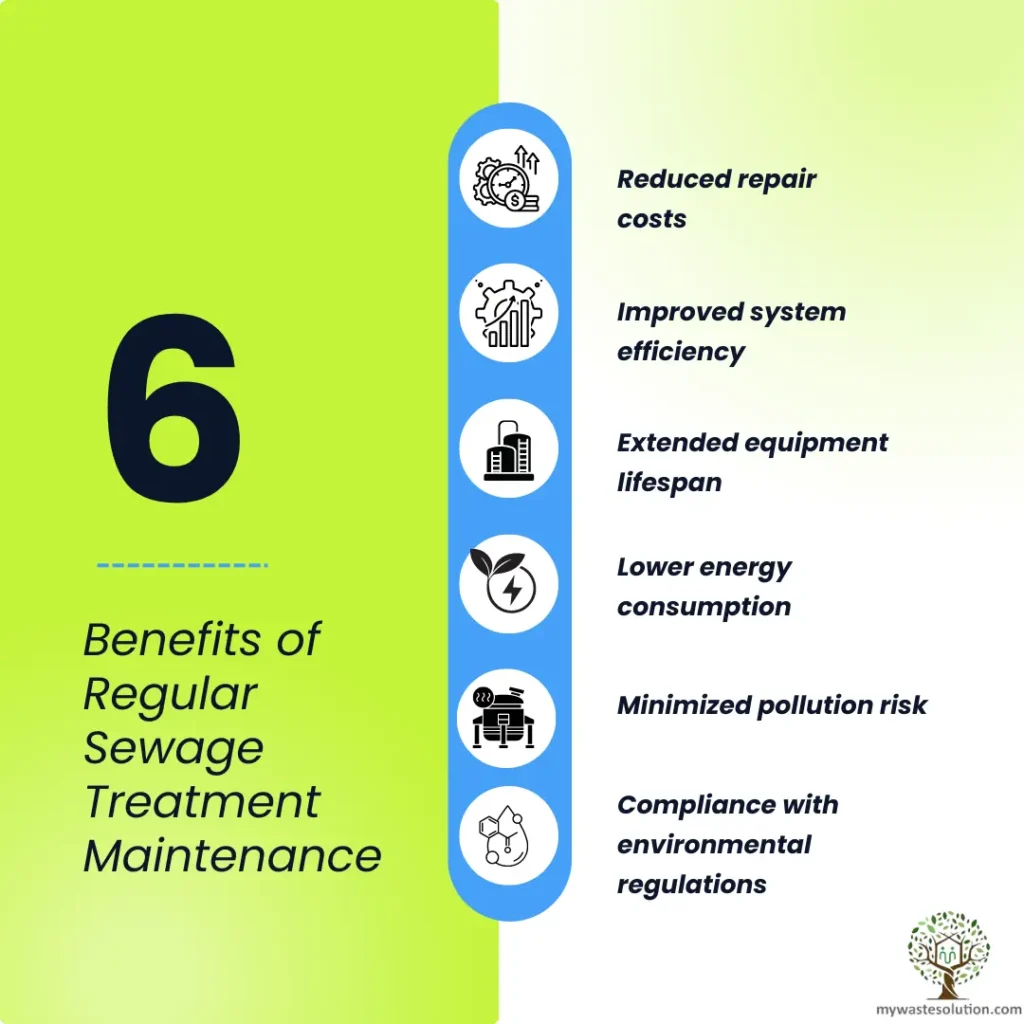
2.1. Hospital Wastewater Sources and Composition
The complex composition of hospital wastewater (HWW) requires specialized sewage treatment for hospitals to manage its diverse contaminants, ensuring environmental protection and public health safety. Hospital wastewater is categorized into blackwater, greywater, stormwater, and specific discharges (Majumder and colleagues, 2021).
Blackwater consists of fecal matter and urine, contributing to high Biochemical Oxygen Demand (BOD) and containing pathogens and antibiotic-resistant microorganisms (Sunta and team, 2019). It also includes unmetabolized pharmaceutically active compounds (PhACs) (Verlicchi and co-authors, 2010).
Greywater comes from washing, bathing, and medical processes, containing surfactants, detergents, and toxic agents like radioactive elements (Kumari and colleagues, 2020). Stormwater is reused for flushing or irrigation, while specific discharges from labs include toxic chemicals such as pharmaceutical residues, solvents, and heavy metals like cadmium, mercury, and copper (Kumari and team, 2020; Verlicchi and co-authors, 2010).
Explore Wastewater Treatment Solutions
Find top machinery, plants, tools, resources, companies, and consultancy for comprehensive sewage treatment plant needs for hospitals.
Fig 2: Comparison of average range of parameters of HWWs and MWWs (Astha et al., 2020).
2.2. Impact of Hospital Wastewater on Treatment Systems
Hospital wastewater (HWW) contains hazardous pollutants such as pharmaceutically active compounds (PhACs), endocrine disruptors, heavy metals, and disinfectants (Muhammad et al., 2021). It has high levels of BOD, COD, TDS, TSS, TOC, TN, and nitrates, along with infectious microbes and multi-drug-resistant bacteria (Parida et al., 2021).
Effective treatment of hospital wastewater is crucial due to its significant environmental impact. Conventional sewage systems cannot handle these contaminants, emphasizing the need for advanced wastewater treatment plants. Specialized technologies, such as a Sewage Treatment Plant for Hospitals, are required to manage these complex pollutants and protect both health and the environment.
| Type of Contaminant | Average concentration in hospital wastewater | Potential effects on environment & human health |
| Pharmaceuticals | Varies depending on usage and discharge rates | – Environmental persistence leading to bioaccumulation in aquatic organisms.-Disruption of endocrine systems in wildlife and potential transfer to the human food chain.-Development of antibiotic-resistant bacteria in natural ecosystems |
| Biological (Pathogens) | High, especially in untreated or poorly treated wastewater | -Contamination of surface water bodies, posing risks of waterborne diseases to humans- Impact on aquatic ecosystems, leading to reduced biodiversity and ecosystem function |
| Chemical (Heavy Metals) | Varies depending on hospital activities and waste disposal practices | – Accumulation in sediments and soils, causing long-term toxicity to aquatic organisms.- Adverse effects on human health through ingestion of contaminated water or food.- Potential leaching into groundwater, compromising drinking water quality. |
3. Top Wastewater Treatment Solutions for Hospitals
Sewage treatment systems for hospitals must address the unique aspects of medical wastewater, which includes pathogens, pharmaceuticals, and chemicals. Conventional wastewater treatment facilities (WWTPs) achieve different removal rates: 20-50% for primary, 30-70% for secondary, and over 90% for tertiary processes (Bhandari et al., 2023).
For managing hospital effluents (HWW), various methods—physical, chemical, and biological—are utilized. Notable techniques include ozonation (Souza et al., 2018), electrochemical oxidation (Ouarda et al., 2019), and chlorination(Guo et al., 2015). Advanced systems like activated sludge (ASP) and membrane bioreactors (MBR), especially when combined with ozonation, are very effective at removing micropollutants (Nguyen et al., 2019; Vo et al., 2019).
Integrated treatment methods are shown to be the most successful in removing complex contaminants from hospital wastewater (Pariente et al., 2022).
3.1. Primary Sewage Treatment Plants for Hospitals
Initial treatment of hospital wastewater involves a crucial mechanical process that removes solids and organic materials through screening and sedimentation, generating primary sludge (Ibiam and Igewnyi, 2012). This step effectively removes large debris, protects downstream equipment, and reduces the organic load. However, initial treatment alone is not sufficient for managing medical effluents, which often include pathogens and pharmaceutical residues.
While important, initial treatment should be part of a comprehensive wastewater management system for medical facilities, integrating advanced methods to thoroughly decontaminate hospital effluents. This is where Sewage Treatment Plant for Hospitals come into play, offering specialized technologies for treating complex contaminants and ensuring environmental protection and public health safety.
Struggling with sewage treatment plants for hospitals? Connect with top consultants specializing in sewage treatment plant solutions.
Connect Now3.2. Secondary Sewage Treatment Plants for Hospitals
Secondary wastewater plants for medical facilities utilize biological processes, mainly bacteria, to break down and purify the waste. Methods such as the activated sludge process (ASP), membrane bioreactors (MBR), and constructed wetlands (CW) are widely used (Majumder et al., 2020). These systems effectively address organic matter, but their ability to remove pharmaceutically active compounds (PhACs) and antibiotic resistance genes (ARGs)depends on the complexity of these pollutants (McCarthy et al., 2021).
While biological systems like ASP, MBR, and CW efficiently treat organic substances, they often require additional steps to fully eliminate pharmaceuticals and meet environmental regulations. This underscores the importance of advanced Sewage Treatment Plants for Hospitals, which can integrate specialized technologies to address the unique challenges of hospital effluents and ensure comprehensive treatment.
3.3. Advanced Wastewater Treatment Solutions for Hospitals
| Treatment Plant Type | Key Characteristics | Pros | Cons |
|---|---|---|---|
| Primary Treatment | Basic physical separation of solids from liquid wastewater | Simple and cost-effective | Limited pollutant removal,not suitable for advanced treatment |
| Secondary Treatment | Biological processes to remove dissolved and suspended solids | Effective for organic matter removal | Requires larger space, may not efficiently remove some pollutants |
| Tertiary Treatment | Advanced processes to further purify water | High removal efficiency for various pollutants | Expensive, energy-intensive, requires skilled operation |
| MBR (Membrane Bioreactor) | Uses membranes for solid-liquid separation in biological treatment | Compact design, high-quality effluent | High capital and operational costs, membrane fouling is a concern |
| AOP (Advanced Oxidation Processes) | Chemical processes to degrade pollutants | Effective for hard-to-treat contaminants, versatile | Energy-intensive, may produce harmful by-products |
| Electrocoagulation | Uses electrical charge to destabilize and remove contaminants | Efficient in removing various pollutants | Requires electricity, maintenance may be challenging |
| Nanotechnology | Uses nanoparticles to treat water pollutants | High removal efficiency for specific contaminants | Costly, potential environmental concerns about nanoparticles |
Advanced treatment plants represent the most sophisticated technologies for processing medical facility effluent, using modern methods to enhance water quality. These processes target remaining solids, harmful microorganisms, and persistent organic compounds, ensuring compliance with environmental and health regulations.
Key techniques include UV disinfection, which effectively removes antimicrobial-resistant (AMR) bacteria and antibiotic resistance genes (ARGs), along with chemical methods like catalytic ozonation and chlorination (McCarthy et al., 2021). Ozonation combines ozone with hydroxyl radicals to neutralize pathogens, while chlorination addresses AMR bacteria, ARGs, and pharmaceutically active substances (Wang and Zhuan, 2020; Chen et al., 2019).
While highly effective, these advanced processes can be energy-intensive and require strategic planning in sewage treatment for hospitals to ensure efficiency and sustainability.
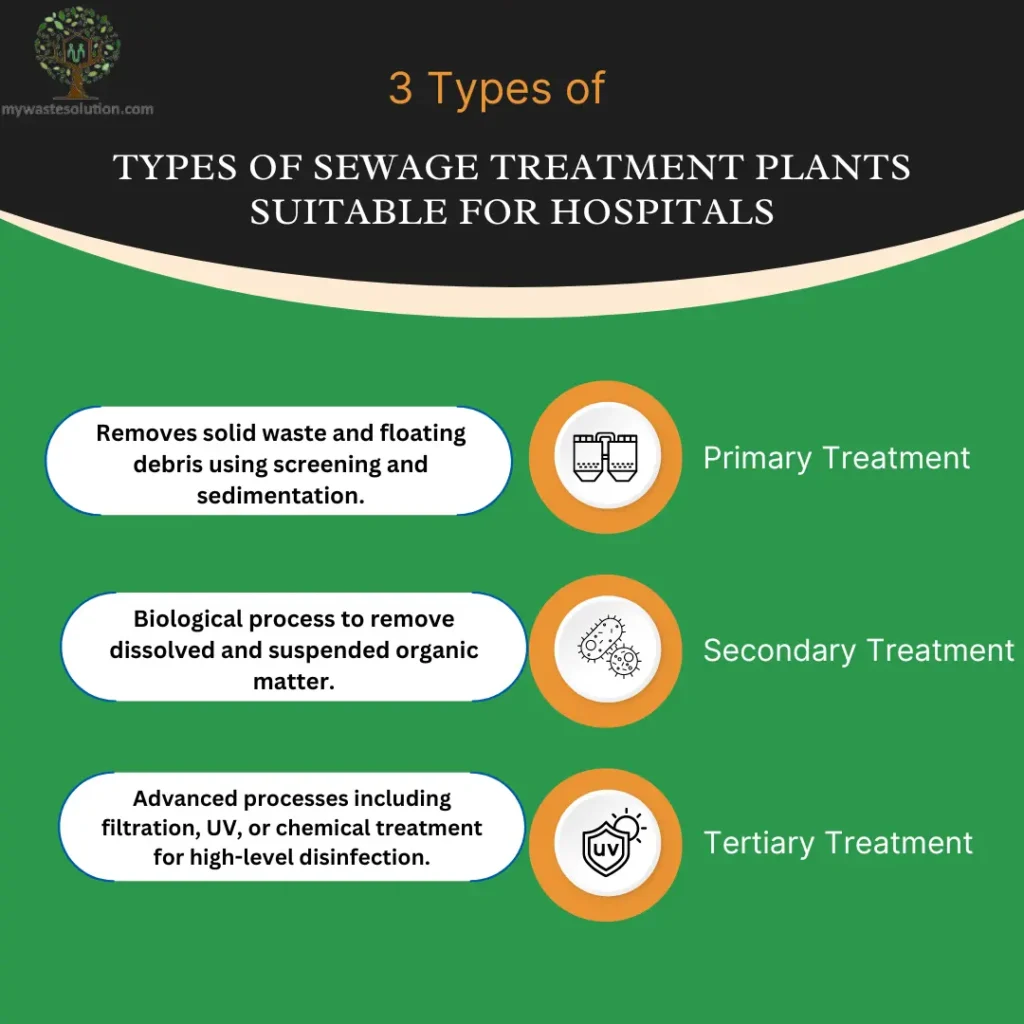
4. Advanced Sewage Treatment Technologies for Hospitals
Despite their high efficiency, these advanced treatment methods are energy-intensive and costly, particularly when handling large volumes of hospital wastewater. For scalable solutions, Sewage Treatment Plants for Hospitals must integrate these high-efficiency technologies with cost-effective and energy-saving strategies. Ongoing research is crucial to improving the feasibility of large-scale implementation, ensuring that Sewage Treatment Plants for Hospitals meet both environmental and economic sustainability goals (Ryan et al., 2019).
4.1. Membrane Bioreactors (MBRs) for Hospital Wastewater
The Membrane Bioreactor (MBR) is an advanced solution for hospital effluent treatment, combining biological processes with membrane filtration to achieve efficient removal of organic matter and nutrients (Pariente et al., 2022). MBR technology is particularly effective in eliminating pharmaceutical compounds (PhACs), with its performance dependent on factors like sludge age, wastewater composition, and environmental conditions such as temperature, pH, and conductivity.
Compared to traditional methods, MBRs offer enhanced effluent quality, require less space, and generate fewer biosolids (Chiarello et al., 2016). However, these systems involve higher operational costs due to the need for continuous aeration and regular maintenance to prevent membrane fouling. Despite these challenges, MBRs are a powerful option for hospital wastewater treatment in healthcare settings, making them a key component of Sewage Treatment Plants for Hospitals.
Find and connect with leading companies specializing in sewage treatment plant management solutions.
Get Connected Today
4.2. Advanced Oxidation Processes (AOPs) in Hospital Sewage Treatment
Advanced Oxidation Processes (AOPs) are a cutting-edge solution for treating hospital effluent, utilizing reactive oxygen species (ROSs) to degrade and remove contaminants in medical wastewater. These reactive compounds oxidize stubborn organic pollutants into less harmful substances through methods like light irradiation, electricity, or catalysts (Choudhary et al., 2021; Ao et al., 2021).
AOPs enhance the efficiency of bioremediation by reducing toxicity and pollutant levels, making them highly effective in removing pharmaceutical residues, pathogens, and other harmful substances (Pandis et al., 2022). Despite their high efficiency, AOPs can be energy-demanding, and their effectiveness depends on the specific composition of the wastewater. Therefore, optimizing operational costs and system performance is crucial for maximizing the benefits of AOPs in effective sewage treatment for hospitals.
4.3. Electrocoagulation for Hospital Sewage Treatment
Electrocoagulation is an innovative wastewater treatment method that utilizes electrochemical processes to remove pollutants. By applying direct current, this technique generates coagulants through the oxidation of an anode, which then interact with ionic species or metal hydroxides, aiding in contaminant removal (Dehghani et al., 2014; Holt et al., 2005).
This process is valued for its simplicity, effectiveness, and operational ease. Compared to conventional methods, it offers advantages such as better sludge settling, reduced sludge volume, and the formation of larger flocs. Additionally, electrocoagulation reduces the use of chemicals, making it an eco-friendly and cost-efficient alternative (Carmona et al., 2006; Onder et al., 2007; Wang et al., 2009). It is particularly efficient in eliminating heavy metals, a crucial aspect of hospital wastewater treatment in Sewage Treatment Plants for Hospitals.
However, challenges such as energy consumption and electrode corrosion can affect the system’s overall cost-efficiency and maintenance (Carmona et al., 2006).
| Technology Name | Description/ Benefits | Advantage for Healthcare Facilities | Reference |
| MBR (Membrane Bioreactor) | Utilizes membranes for solid-liquid separation in biological treatment | Compact design saves space in healthcare facilities,High removal efficiency toward organic compounds, Reduced need for secondary clarifiers and sludge handling | Zhao et al., 2022 |
| AOP (Advanced Oxidation Processes) | Chemical processes to degrade pollutants | Effective in breaking down pharmaceuticals and pathogens, Versatile for treating a wide range of contaminants, May help in addressing emerging pollutants in healthcare waste | (Pandis et al., 2022). |
| Electrocoagulation | Uses electrical charge to destabilize and remove contaminants | Efficient removal of heavy metals and pathogens, Applicable for decentralized treatment in healthcare settings, Potential for reducing sludge production in the process | (Dehghani et al., 2014) |
| Nanotechnology | Uses nanoparticles to treat water pollutants | High precision in targeting specific contaminants, Potential for addressing nanoscale pollutants in healthcare waste, High adsorption efficiency | Bagheri et al., 2016 |
4.4. Nanotechnology in Hospital Sewage Treatment
Nanotechnology is transforming wastewater treatment, especially in tackling pharmaceutical contaminants in hospital wastewater (HWW). By leveraging the unique properties of nanomaterials, highly efficient sorbents are developed to capture and eliminate pharmaceuticals (Tiwari et al., 2008; Afkhami et al., 2010; Bagheria et al., 2016).
Nanoscale membranes, nanoparticles, and nanostructured adsorbents enhance filtration, improving the removal of pathogens and drug residues. For instance, photocatalytic nanomaterials like titanium dioxide help degrade organic pollutants through advanced oxidation when exposed to light.
Furthermore, nano-enabled sensors offer real-time monitoring of water quality, streamlining treatment processes. Nanotechnology provides significant benefits, including improved efficiency, a smaller system footprint, and superior pathogen removal in effective sewage treatment for hospitals.
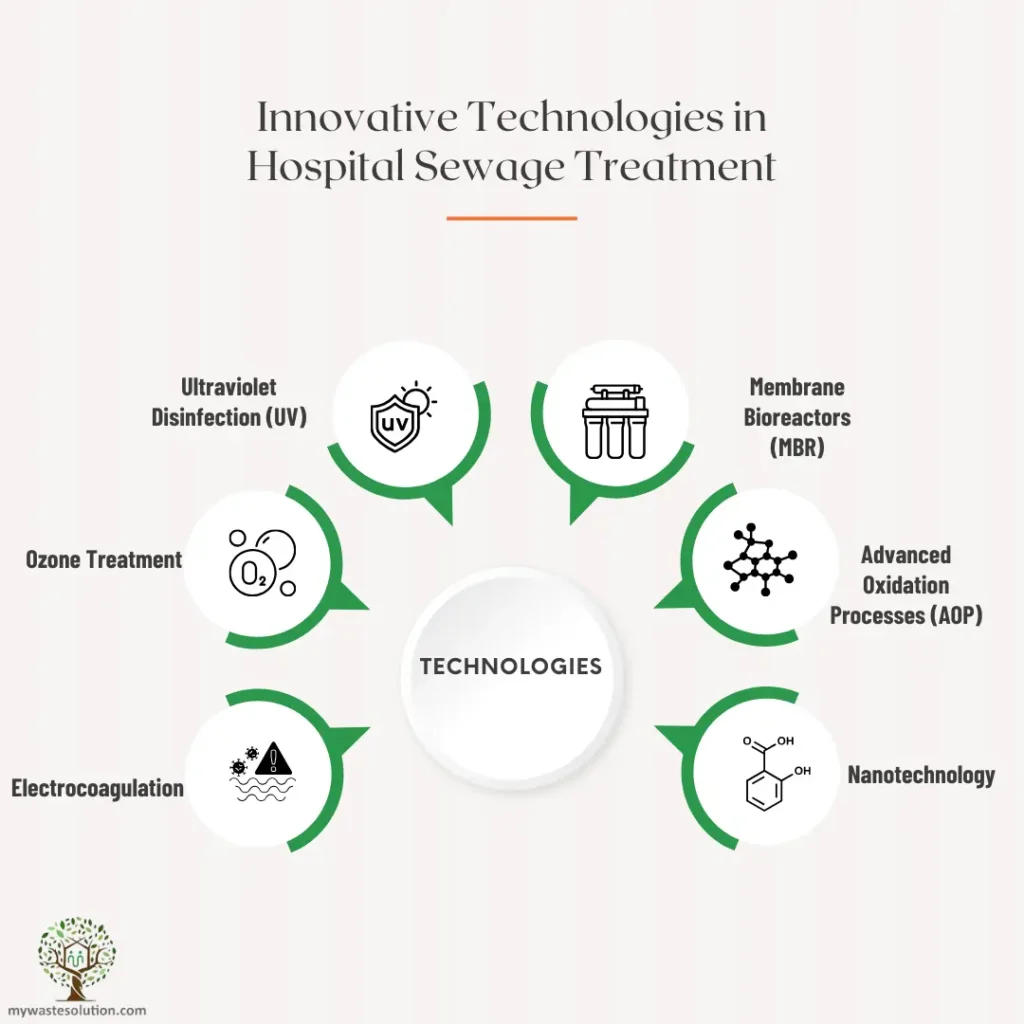
4.5. Smart Sewage Treatment Systems for Hospitals
Smart sewage treatment systems for hospitals utilize sensors, automation, AI, and remote monitoring to optimize operations for hospital wastewater (HWW). AI enhances wastewater treatment by improving process design, water quality monitoring, and performance prediction (Wang et al., 2023). These intelligent systems allow for real-time adjustments, increasing efficiency and effectiveness.
AI-driven analytics improve pattern recognition and predictive modeling, leading to better outcomes. Automated controls and predictive maintenance minimize downtime, while cloud-based platforms enable remote access to system data. These innovations are becoming critical for Sewage Treatment Plants for Hospitals to ensure optimal treatment and compliance with environmental standards.
However, challenges include high costs, energy use, and concerns around cybersecurity and data privacy.
5. Successful Case Studies of Sewage Treatment in Hospitals
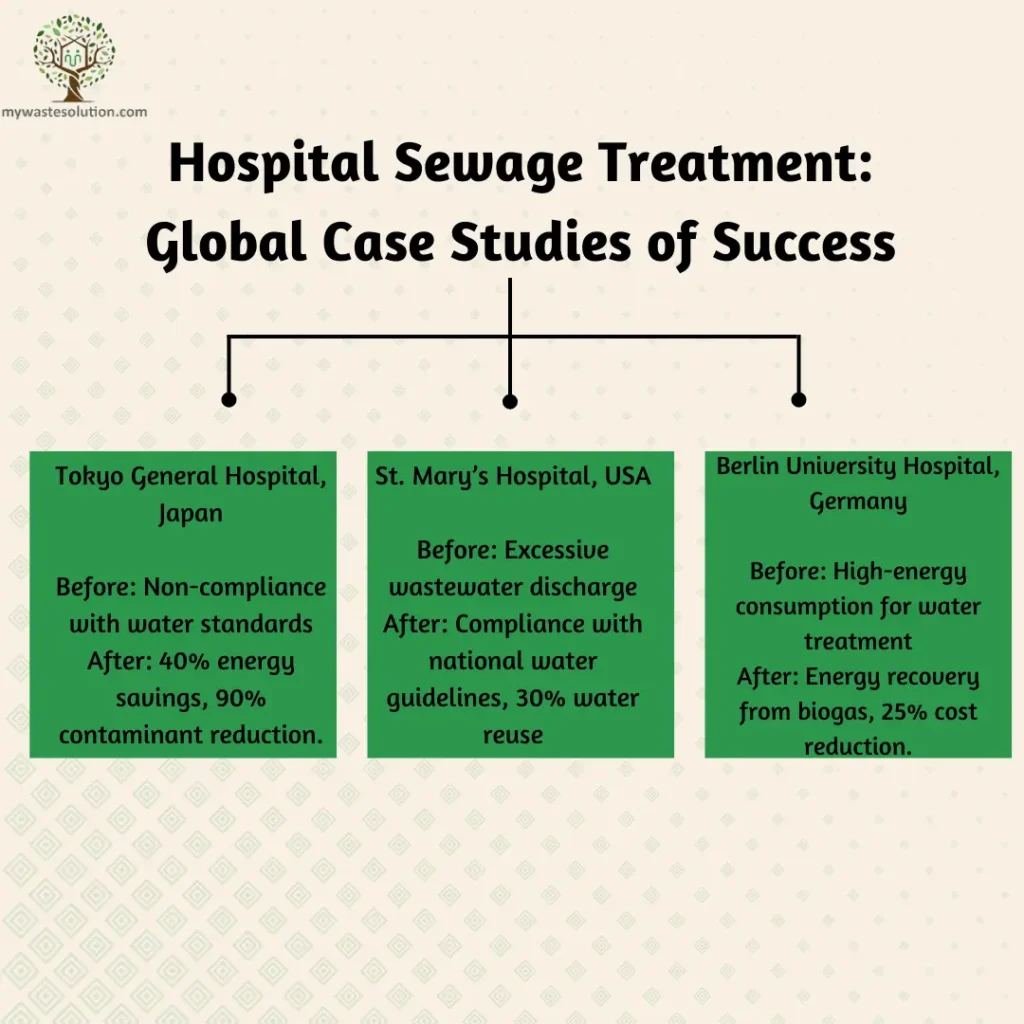
5.1. MLD Sewage Treatment Plant at Kozhikode Medical College Hospital, Kerala
Kozhikode Medical College Hospital operates a 2-MLD treatment facility utilizing electrolytic technology and 18 reactors, recently expanded to handle 5 MLD. This adaptable system optimizes efficiency by adjusting to wastewater volume. The plant processes toilet effluent from nearby wards, delivered by tankers, and channels waste through a 1,400-meter pipeline network connecting campus buildings. Currently, treated effluent is discharged into the Conolly Canal, with future plans for reuse in gardening and flushing, underscoring a commitment to sustainable water management. This case illustrates the integration of advanced technologies, strategic capacity planning, and innovative reuse initiatives in effective sewage treatment for hospitals.
5.2. MBR-Based Wastewater Treatment Plant at Kamakshi Hospital, Visakhapatnam, Andhra Pradesh
Kamakshi Hospital met the demand for high-quality treated effluent in critical areas, such as the dialysis unit, by installing an MBR-based treatment system. This facility, equipped with dual filtration layers, ensures compliance with environmental standards and provides clean recycled water for hospital use. Additionally, an Energy-Efficient Heat Pump was installed to supply temperature-controlled water, enhancing both comfort and sustainability while promoting energy savings. This case demonstrates the successful integration of advanced sewage treatment technologies in Sewage Treatment Plants for Hospitals, contributing to both environmental compliance and energy efficiency.

Explore the sewage treatment plant for hospital sewage treatment.
Connect Today5.3. Al-Mauany Hospital Sewage Treatment Plant in Basrah City, Iraq
The Al-Mauany Hospital in Basrah Governorate implemented an MBR-based wastewater treatment system, showing significant environmental benefits. A study by Khafaji and colleagues (2023) assessed its efficiency, revealing changes in key parameters such as COD, BOD, DO, and nitrogen compounds. The system reduced COD by 80% in the summer and 79% in the winter, while BOD5 levels dropped by 74% and 69% for the same periods. The BOD5/COD ratio indicated good bio-treatability.
The removal of NH3-N reached 86% in summer and 83% in winter, meeting required standards. Turbidity reductionwas also significant, with 70% removal in summer and 66% in winter. Though suspended solids removal was less efficient due to biofilm accumulation in the aeration basin, overall results showed effective sewage treatment for hospitals in addressing most contaminants.
6. How to Choose the Right Sewage Treatment Plant for Your Hospital
Selecting the right sewage treatment system for hospitals is essential for efficient wastewater management (Cetkovic et al., 2023). Key factors to consider are:
- Daily wastewater volume: Assess average output.
- Effluent composition: Analyze contaminant levels, including pharmaceuticals and pathogens.
- Available space: Ensure sufficient space for installation of a sewage treatment plant.
- Budget: Consider both setup and operational costs, including energy efficiency and maintenance.
Technologies include:
- Membrane Bioreactors (MBRs): Provide high-efficiency treatment but come with higher operational costs.
- Advanced Oxidation Processes (AOPs): Effective for complex pollutants but are energy-intensive.
- Electrocoagulation: Requires low chemical use but needs regular upkeep.
Evaluating long-term sustainability, energy efficiency, and maintenance requirements is critical to meeting hospital goals and environmental standards.
Fig 3: Energy savings related to proposed measures in 47 wastewater treatment plants in Germany [Kaste, 2003]
6.1. Technology Options for Hospital Sewage Treatment
When selecting wastewater solutions for hospitals, prioritize technologies that meet regulatory standards and offer cost-effective solutions. Conventional municipal systems often fall short in removing micropollutants and antibiotic-resistant genes (ARGs), making advanced treatment essential for environmental protection and public health (Beier et al., 2011; Khan et al., 2020).
Key technologies to consider:
- Membrane Bioreactors (MBRs): Space-efficient, low-maintenance, and effective in organic matter removal and high-quality effluent production (Biasea et al., 2019).
- Advanced Oxidation Processes (AOPs): Effective for degrading complex pollutants like pharmaceuticals and pathogens.
- Electrocoagulation: Cost-effective and versatile, suitable for various facility sizes, removing contaminants through electrochemical reactions.
- Nanotechnology: Enhances filtration and catalytic properties with nanoscale membranes and photocatalytic materials.
- Smart Treatment Systems: Utilize sensors, automation, data analytics, and AI for real-time monitoring and optimization in sewage treatment for hospitals.
Tailor the technology to your hospital’s needs for optimal performance and cost-efficiency.
| Treatment | Efficiency | Initial Cost | Operational Cost | Space Required | Suitability for Hospitals |
| MBR | High removal efficiency for various pollutants | Moderate to high | Moderate to high | Compact Design | Suitable for medium to large hospitals |
| AOP | Effective for hard to treat contaminants | Moderate to high | Moderate to high | Depends on specific AOP | Applicable to various hospital sizes |
| Electrocoagulation | Efficient removal of heavy metals & pathogens | Moderate | Moderate | Requires moderate space | Suitable for small to medium hospitals |
| Nanotechnology | High precision in targeting specific contaminants | High | High | Requires minimal space | May be suitable for various hospital sizes |
| Primary Treatment | Limited pollutant removal,basic separation | Low to moderate | Low to moderate | Moderate space | Suitable for small hospitals |
| Secondary | Effective for organic matter removal | Moderate | Moderate | Moderate to large space | Suitable for medium to large hospitals |
| Tertiary | High removal efficiency for various pollutants | High | High | Requires substantial space | Suitable for large hospitals |
6.2. Environmental Impact of Hospital Sewage Treatment Systems
Hospital effluents contain complex, hazardous pollutants such as pharmaceutically active compounds (PhACs), endocrine disruptors, hormones, heavy metals, disinfecting agents, cytotoxics, and radioisotopes (Khan et al., 2021). Hospital wastewater (HWW) is typically high in Biochemical Oxygen Demand (BOD), Chemical Oxygen Demand (COD), Total Dissolved Solids (TDS), Total Suspended Solids (TSS), Total Organic Carbon (TOC), Total Nitrogen (TN), nitrites, nitrates, and Total Phosphorus (TP) (Majumder et al., 2021), and often contains infectious microbes, multi-drug-resistant organisms, and antibiotic resistance genes (ARGs) (Parida et al., 2021). Effective sewage treatment for hospitals is crucial to mitigate environmental impacts and safeguard public health.
Sustainable sewage treatment technologies can significantly reduce hospitals’ environmental footprint:
- Membrane Bioreactors (MBRs): Offer space-efficient solutions and high-quality effluent with reduced waste byproducts.
- Advanced Oxidation Processes (AOPs): Address complex pollutants, minimizing harmful byproducts and enhancing water quality.
- Smart Treatment Systems: Optimize processes and resource use, contributing to energy efficiency and waste reduction.
Integrating these technologies helps hospitals meet regulatory standards and supports environmentally responsible practices, promoting a healthier future for the community and planet.
7. Cost Analysis of Hospital Sewage Treatment
Conducting a sewage treatment plant cost analysis for hospital systems involves evaluating both startup and ongoing expenses:
Startup Costs:
- Acquisition and Installation: Includes purchasing and setting up technologies like Membrane Bioreactors (MBRs), Advanced Oxidation Processes (AOPs), and Smart Treatment Systems, along with necessary infrastructure and technology setup.
- Infrastructure Requirements: Costs for building or modifying facilities to support the selected treatment technology for hospital wastewater management.
Ongoing Expenses:
- Energy Consumption: Costs for powering processes such as electrocoagulation, advanced oxidation, and membrane filtration.
- Maintenance: Regular costs for cleaning, repairs, and replacement of parts or membranes to ensure system efficiency.
- Labor: Staffing costs for operating and managing the treatment plant.
- Waste Disposal: Costs for disposing of residual sludge and other byproducts.
Assessing these factors helps hospitals choose a sewage treatment solution that is both cost-effective and compliant with regulations, ensuring long-term operational efficiency and sustainability.
Fig 4: Initial costs for primary and secondary treatment plants both equipment and construction costs (Ozgun et al., 2021).
7.1. Comparing Hospital Sewage Treatment Technologies
When assessing sewage treatment technologies for hospitals, it’s crucial to evaluate both startup and ongoing expenses, alongside design and engineering considerations (Ahmad, 2019). Here’s a comparison of different technologies based on their costs and features:
- Sequential Batch Reactor (SBR): Moderate startup and running expenses. Effective for batch treatment with flexibility, though it can be complex to operate.
- Activated Sludge Process (ASP): Moderate costs, well-established for efficient organic matter removal but requires considerable space and management.
- Moving Bed Biofilm Reactor (MBBR): Moderate initial and ongoing expenses. Compact design with effective organic matter removal, though regular monitoring is needed.
- Upflow Anaerobic Sludge Blanket (UASB): Low startup and running costs, energy-efficient with high organic load handling, but produces large volumes of sludge.
- Membrane Bioreactors (MBRs): High initial and ongoing costs due to membrane use. Offers excellent efficiency and compact design, but membrane fouling can be an issue.
- Waste Stabilization Pond (WSP): Low-cost with minimal operational expenses, effective in warm climates, but requires large land areas.
- Advanced Oxidation Processes (AOPs): High startup and running costs due to advanced equipment. Highly effective for removing persistent contaminants, though maintenance can be costly.
- Electrocoagulation: Moderate initial costs with low running expenses. Cost-effective with less sludge production but involves energy consumption and electrode wear.
- Nanotechnology: Costs vary significantly. Enhances filtration and catalytic properties but can be expensive.
- Smart Sewage Treatment Systems: Moderate initial investment with ongoing costs related to energy and maintenance. Offers optimization and long-term efficiency but can be complex and costly.

Selecting the right technology involves balancing hospital needs, efficiency improvements, energy use, and long-term sustainability goals to meet environmental and budgetary requirements.
Table 2: Comparison of Operation & Maintenance cost of various technologies for STP (Tare V., 2010)
7.2. Hospital Sewage Treatment Financing Options
Financing wastewater management, especially for wastewater treatment plants (WWTPs), can be challenging but is crucial for successful operation and environmental enhancement (Juszczyk et al., 2020; Perez et al., 2014). Effective financing strategies are essential for aligning financial and environmental objectives.
Modern economic cost-benefit analysis (CBA) incorporates both financial and environmental impacts, such as health improvements, reduced disease rates, and decreased mortality (Dixon, 2011; Dixon, 2012; Dixon, 2013).
Key financing options for sewage treatment plants include:
- Government Grants and Subsidies: Help cover initial costs for hospital wastewater treatment.
- Public-Private Partnerships (PPPs): Share financial responsibilities for sewage treatment plants.
- Environmental Bonds: Raise capital for projects related to wastewater management.
- Loans and Credit Facilities: Spread out the costs of advanced sewage treatment systems.
- Carbon Credits: For projects aimed at reducing greenhouse gases from hospital effluent.
- Cost Sharing and User Fees: Distribute financial responsibilities for wastewater treatment plants.
A diverse financing strategy aligns financial management with environmental and public health goals.

8. Regulatory and Environmental Factors in Hospital Wastewater Treatment
When selecting sewage treatment plants for hospitals, complying with environmental regulations is essential. These regulations ensure responsible wastewater management, legal compliance, and the protection of public health.
Assessing the environmental impact of sewage treatment technologies is critical. This includes evaluating their effects on ecosystems, water resources, and air quality. Key factors involve the system’s ability to meet effluent quality standards, minimize energy use, and handle waste byproducts efficiently.
Hospitals must align regulatory compliance with environmental sustainability. Achieving this ensures effective wastewater management and reflects a commitment to both legal and environmental responsibilities.
Fig 5 : Percentage reduction of the pollutant indicators in subsequent sewage treatment stages (Dariusz et al., 2020).
8.1. Local and National Wastewater Regulations
Globally, nations have established various regulations for managing pollutants in aquatic bodies, including:
- WHO Guidelines
- US Clean Water Act (1972)
- USEPA Standards
- Indian Biomedical Waste (Management and Handling) Rules (1998)
- EU Water Framework Directive (1991)
- China’s Discharge Standards for Water Pollution from Medical Institutions
However, enforcement remains inconsistent in many regions (Majumder et al., 2019). In India, the Bio-medical Waste (Management & Handling) Rules, 1998, enforced by the Ministry of Environment & Forests (MoEF) under the Environment (Protection) Act, 1986, mandate oversight by State Pollution Control Boards (SPCBs) or Pollution Control Committees (PCCs) (Verlicchi, 2018).
Despite regulations like the EPA’s Effluent Guidelines and WHO’s Safe Management of Wastes from Healthcare Activities, there is often a lack of specific standards for pollutants such as pharmaceuticals (PhACs) and personal care products. This results in varied characteristics of effluent worldwide (Kumari et al., 2020; Majumder et al., 2021).
| Regulation/Standard | Summary of Requirements | Potential Penalties for Non-Compliance |
| Central Pollution Control Board (CPCB) Guidelines for Hospital Waste Management | Defines standards for hospital wastewater treatment, including specific parameters and permissible limits | Fines, legal actions, closure of facilities for non-compliance |
| Water (Prevention and Control of Pollution) Act, 1974 | Regulates water pollution, sets standards for wastewater discharge, including from healthcare facilities | Fines, legal actions, closure of facilities for non-compliance |
| Environment (Protection) Act, 1986 | Provides a framework for environmental protection, mandates compliance with wastewater treatment standards | Fines, legal actions, closure of facilities for non-compliance |
| Biomedical Waste Management Rules, 2016 | Specifies requirements for biomedical waste management, which may include wastewater from healthcare facilities | Fines, legal actions, closure of facilities for non-compliance |
| National Ambient Air Quality Standards (NAAQS) | Sets air quality standards indirectly influencing wastewater treatment practices in healthcare settings | Fines, legal actions, closure of facilities for non-compliance |
| State Pollution Control Boards (SPCBs) regulations | State-specific regulations complementing national standards for wastewater treatment in healthcare facilities | Fines, legal actions, closure of facilities for non-compliance |
8.2. Green Initiatives for Sewage Treatment
A Green Hospital prioritizes both public health and environmental sustainability by reducing its impact on disease burden and enhancing eco-friendly practices (Azmal et al., 2014). Key initiatives include:
- Efficient Water Use: Implementing rainwater harvesting, water-saving fixtures, and wastewater treatment and recycling systems.
- Green Design: Incorporating green roofing and managing stormwater releases.
- Renewable Energy: Integrating renewable energy sources to minimize reliance on non-renewable resources.
- Nature-Based Treatments: Utilizing natural treatment approaches for improved wastewater management.
- Resource Recovery: Adopting systems for recovering valuable resources from waste.
By exceeding environmental standards and regulatory requirements, Green Hospitals manage sewage responsibly and contribute positively to the environment (Kumari and Kumar, 2020).
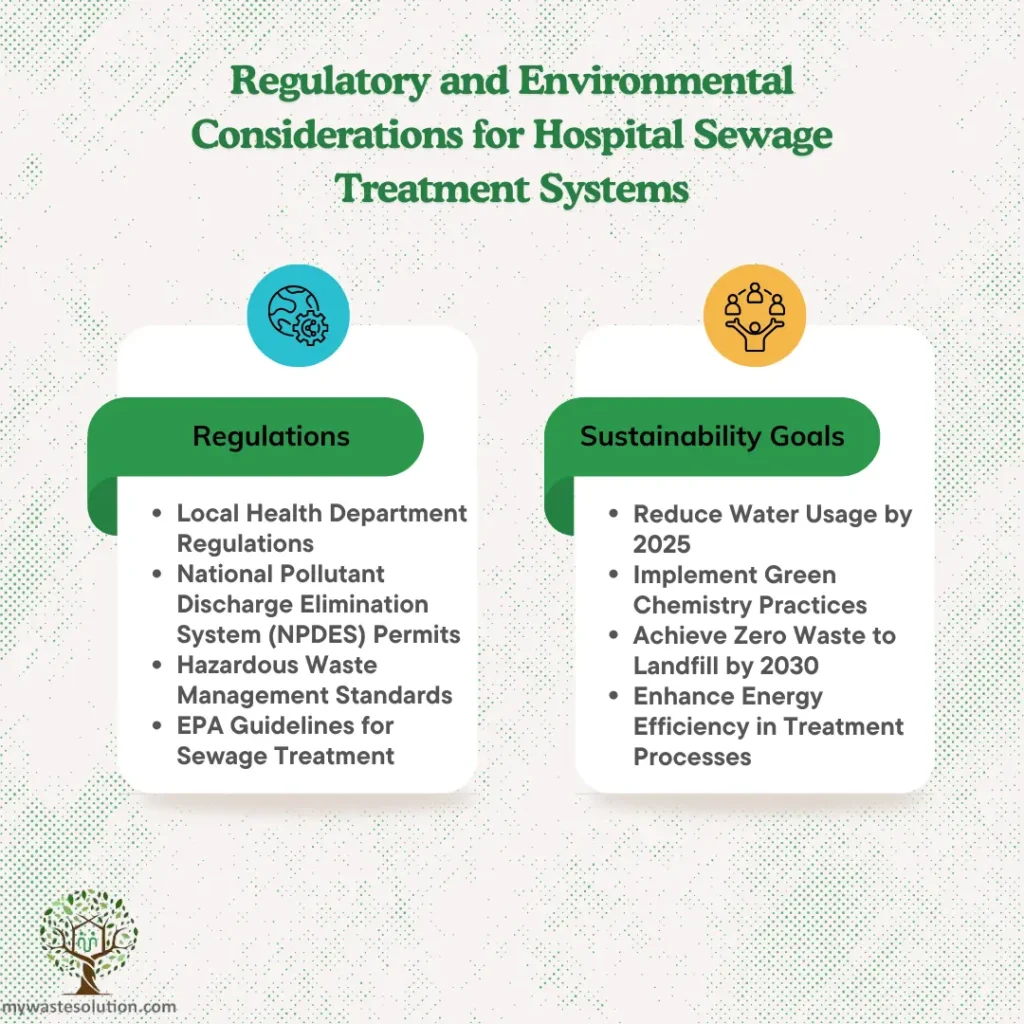
9. Conclusion: Effective Wastewater Management in Hospitals
Establishing efficient hospital wastewater treatment systems requires a comprehensive strategy that balances regulatory compliance, technological innovation, and sustainability. By choosing the right wastewater treatment technology tailored to their needs and environmental impact, healthcare institutions can manage sewage effectively while promoting responsible resource use.
Green initiatives emphasize adopting eco-friendly practices to support sustainability goals. Adhering to local, state, and federal regulations ensures legal compliance and demonstrates a commitment to environmental and public health responsibilities.
As the healthcare industry progresses, integrating smart technology, renewable energy sources, and effective water management will shape the future of wastewater treatment. Embracing these innovative solutions enables hospitals to address wastewater management challenges and set a standard for sustainable and ethical healthcare practices.
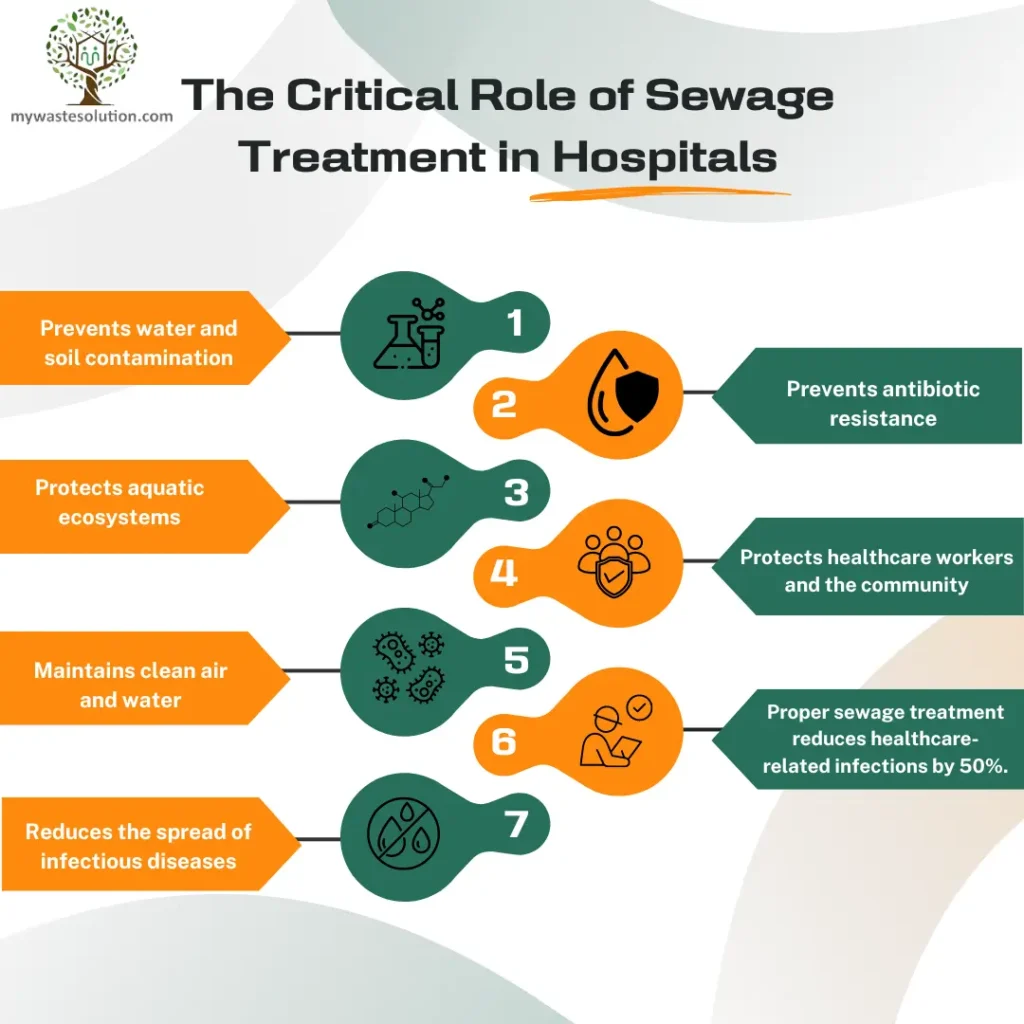
10. “References and Further Reading”
H. Zhou., D. W. Smith., 2002. Advanced Technologies in Water and Wastewater Treatment, J. Environ. Engg. Sci. 1, 247-264.
Mike Williams, Rai, S., Kookana., 2018. Chapter 3 – Fate and Behavior of Environmental Contaminants Arising From Health-Care Provision. Elsevier. 21-40.
Dires, S., Birhanu, T., Ambelu, A., Sahilu, G., 2018. Antibiotic resistant bacteria removal of subsurface flow constructed wetlands from hospital wastewater. J. Environ. Chem. Eng. 6, 4265–4272.
Lien, L., Hoa, N., Chuc, N., Thoa, N., Phuc, H., Diwan, V., Dat, N., Tamhankar, A., Lundborg, C., 2016. Antibiotics in wastewater of a rural and an urban hospital before and after wastewater treatment, and the relationship with antibiotic use—a one year study from Vietnam. IJERPH. 13:588.
Nielsen, U., Hastrup, C., Klause,n M.M., Pedersen, B.M., Kristensen, G.H., Jansen J.L.C., Bak, S.N., Tuerk, J., 2013. Removal of APIs and bacteria from hospital wastewater by MBR plus O 3, O3 + H2O2, PAC or ClO2. Water Sci. Technol. 67, 854–862.
Kwak, Y.K., Colque, P., Byfors, S., Giske, C.G., Möllby, R., Kühn, I., 2015. Surveillance of antimicrobial resistance among Escherichia coli in wastewater in Stockholm during 1 year: Does it reflect the resistance trends in the society? Int. J. Antimicrob. Agents. 45, 25–32.
lbiam, O. F. A., Igewnyi, I. O., 2012. Sewage management and its benefits to man. International Research Journal of Biotechnology. 3(10}, 174-189.
S., Mohankumar and Dr.K., Kottaiveeran., 2011. Hospital Waste Management and Environmental Problems in India. International Journal of Pharmaceutical & Biological Archives. 2(6), 1621-1626.
Mira Čelić., Meritxell Gros., Marinella Farré., Damia Barceló., Mira Petrović., 2019. Pharmaceuticals as chemical markers of wastewater contamination in the vulnerable area of the Ebro Delta (Spain). Science of The Total Environment. 652, 952-963.
Preeti Gupta, N., Mathur, P., Bhatnagar, P., Nagar, S., Srivastava. 2009. Genotoxicity evaluation of hospital wastewaters. Ecotoxicology and Environmental Safety. 72 (7), 1925-1932.
Astha Kumari., Nityanand Singh Maurya., Bhagyashree Tiwari., 2020. Hospital wastewater treatment scenario around the globe. Current Developments in Biotechnology and Bioengineering, Elsevier, 549-570.
Macarena Munoz., Gema Pliego., Zahara, M., de Pedro., Jose, A., Casas, Juan, J., Rodriguez., 2014. Application of intensified Fenton oxidation to the treatment of sawmill wastewater. Chemosphere. 109, 34-41.
E., Emmanuel, Y., Perrodin, G., Keck, J.M., Blanchard, P., Vermande., 2004. Ecotoxicological risk assessment of hospital wastewater: a proposed framework for raw effluents discharging into urban sewer networks. Journal of Hazardous Materials. 117(1), 1-11.
Ajay Kumar Gautam., Sunil Kumar, P.C., Sabumon, 2007. Preliminary study of physico-chemical treatment options for hospital wastewater. Journal of Environmental Management. 83 (3), 298-306.
Zotesso, J.P., Cossich, E.S., Janeiro, V., 2017. Treatment of hospital laundry wastewater by UV/H2O2 process. Environ. Sci. Pollut. Res. 24, 6278–6287.
World Health Organisation (WHO) Safe management of wastes from health-care activities. WHO Library., 2013. 2, 105–124.
Sanaa, D., Bouchaib, B., Nadia, B., & Said, E. A., 2019.Diagnosis of the Management of Liquid Effluents in the Casablanca-Settat Region. European Scientific Journal ESJ. 15(6).
Bouzid, J., Jaouhar, S., Zaid, A., Bouhlou, L., & Chahlaoui, A., 2021. Evaluation of the bacteriological and physicochemical risk of hospital effluents: Case of the Mohamed V Hospital in Meknes. Édité par S., Bourekkadi, H., Hami, A., Mokhtari, K., Slimani, et A., Soulaymani. E3S Web of Conferences. 319, 01105.
Achak, M., Bakri, S. A., Chhiti, Y., Alaoui, F. E, M. H., Barka, N., & Boumya, W. 2021. SARS-CoV-2 in hospital wastewater during outbreak of COVID-19: A review on detection, survival and disinfection technologies. Science of The Total Environment. 761, 143192.
Carraro, E., Bonetta, S., Bonetta, S., 2018. The Handbook of Environmental Chemistry Series. Springer Verlag. Hospital wastewater: existing regulations and current trends in management. 1–16.
Šunta, U., Žitnik, M., Finocchiaro, N.C., Bulc, T.G., Torkar, K.G., 2019. Fecal indicator bacteria and antibiotic-resistant β-lactamase producing Escherichia coli in blackwater: a pilot study. Arh. Hig. Rada Toksikol. 70,140–148.
Verlicchi, P., Galletti, A., Petrovic, M., Barcel, Ó D., 2010. Hospital effluents as a source of emerging pollutants: an overview of micropollutants and sustainable treatment options. J. Hydrol. 389, 416–428.
Oliveira, T.S., Murphy, M., Mendola, N., Wong, V., Carlson, DWaring L.,2015. Characterization of pharmaceuticals and personal care products in hospital effluent and wastewater influent/effluent by direct-injection LC-MS-MS. Sci. Total Environ. 518–519, 459–478
Muhammad Tariq Khan., Izaz Ali Shah., Ihsanullah Ihsanullah., Mu. Naushad., Sharafat Ali., Syed Hassan Ali Shah., Abdul Wahab Mohammad., 2021. Hospital wastewater as a source of environmental contamination: An overview of management practices, environmental risks, and treatment processes. Journal of Water Process Engineering. 41,101990.
Abhradeep Majumder., Ashok Kumar Gupta., Partha Sarathi Ghosal., Mahesh Varma., 2021. A review on hospital wastewater treatment: A special emphasis on occurrence and removal of pharmaceutically active compounds, resistant microorganisms, and SARS-CoV-2. Journal of Environmental Chemical Engineering. 9(2), 104812.
Vishal Kumar Parida., Duduku Saidulu., Abhradeep Majumder., Ashish Srivastava., Bramha Gupta., Ashok Kumar Gupta., 2021. Emerging contaminants in wastewater: A critical review on occurrence, existing legislations, risk assessment, and sustainable treatment alternatives. Journal of Environmental Chemical Engineering. 9(5), 105966.
Souza, F. S., Da Silva, V. V., Rosin, C. K., Hainzenreder, L., Arenzon, A., Pizzolato, T., Jank, L., & Féris, L. A., 2018. Determination of pharmaceutical compounds in hospital wastewater and their elimination by advanced oxidation processes. Journal of Environmental Science and Health, Part A. 53(3), 213–221.
Ouarda, Y., Bouchard, F., Azaïs, A., Vaudreuil, M. A., Drogui, P., Tyagi, R. D., Sauvé, S., Buelna, G., & Dubé, R., 2019. Electrochemical treatment of real hospital wastewaters and monitoring of pharmaceutical residues by using surrogate models. Journal of Environmental Chemical Engineering, 7(5), 103332.
Guo, M.T., Yuan, Q. B., & Yang, J., 2015. Distinguishing effects of ultraviolet exposure and chlorination on the horizontal transfer of antibiotic resistance genes in municipal wastewater. Environmental Science & Technology, 49(9), 5771–5778.
Mir-Tutusaus, J. A., Jaén Gil, A., Barceló, D., Buttiglieri, G., Gonzalez-Olmos, R., Rodriguez-Mozaz, S., Caminal, G., & Sarrà, M., 2021. Prospects on coupling UV/H2O2 with activated sludge or a fungal treatment for the removal of pharmaceutically active compounds in real hospital wastewater. Science of The Total Environment, 773, 145374.
Nguyen, T. T., Bui, X. T., Dang, B. T., Ngo, H. H., Jahng, D., Fujioka, T., Chen, S. S., Dinh, Q. T., Nguyen, C. N., & Nguyen., P. T. V., 2019. Effect of ciprofloxacin dosages on the performance of sponge membrane bioreactors treating hospital wastewater. Bioresource Technology, 273, 573–80.
Vo, T. K. Q., Bui, X. T., Chen, S. S., Nguyen, P. D., Cao, N. D. T., Vo, T. D. H., Nguyen, T. T., & Nguyen, T. -B., 2019. Hospital wastewater treatment by sponge membrane bioreactor coupled with ozonation process. Chemosphere. 230, 377–83.
Geeta Bhandari., Parul Chaudhary., Saurabh Gangola., Sanjay Gupta., Ashulekha Gupta., Mohd Rafatullah., Shaohua Chen., 2023. A review on hospital wastewater treatment technologies: Current management practices and future prospects. Journal of Water Process Engineering. 56, 104516.
McCarthy,B., Apori,S.O., Giltrap, M., Bhat, A., Curtin, J., Tian, F., 2021. Hospital Effluents and Wastewater Treatment Plants: A Source of Oxytetracycline and Antimicrobial- Resistant Bacteria in Seafood. Sustainability. 13,13967.
Wang, J., Zhuan, R., 2020. Degradation of antibiotics by advanced oxidation processes: An overview. Sci. Total Environ. 701, 135023.
Chen, J., Deng, W., Liu, Y., Hu, L., He, L., Zhao, J., Wang, T., Ying, G., 2019. Fate and Removal of Antibiotics and Antibiotic Resistance Genes in Hybrid Constructed Wetlands. Environ. Pollut. 249, 894–903.
M.I., Pariente, Y., Segura, S., Álvarez-Torrellas, J.A. Casas, Z.M., de Pedro, E., Diaz, J., García, M.J., López-Muñoz, J., Marugán, A.F., Mohedano, R., Molina, M., Munoz, C., Pablos, J.A., Perdigón-Melón, A.L., Petre, J.J., Rodríguez, M., Tobajas, F., Martínez., 2022. Critical review of technologies for the on-site treatment of hospital wastewater: From conventional to combined advanced processes. Journal of Environmental Management. 320, 115769.
Y., Luo, W., Guo, H.H., Ngo, L.D., Nghiem, F.I., Hai, J., Zhang, S., Liang, X.C., Wang., 2014. A review on the occurrence of micropollutants in the aquatic environment and their fate and removal during wastewater treatment. Sci. Total Environ.
M., Chiarello, L., Minetto, S.V.D., Giustina, L.L. Beal, S., Moura., 2016. Popular pharmaceutical residues in hospital wastewater: quantification and qualification of degradation products by mass spectroscopy after treatment with membrane bioreactor. Environ. Sci. Pollut. Control Ser. 8, 1133-1176.
Xiu-wei Ao., Jussi Eloranta., Ching-Hua Huang., Domenico Santoro., Wen-jun Sun., Ze-dong Lu., Chen Li., 2021. Peracetic acid-based advanced oxidation processes for decontamination and disinfection of water: A review, Water Research. 188,116479.
Pandis, P.K., Kalogirou, C., Kanellou, E., Vaitsis, C., Savvidou, M.G., Sourkouni, G., Zorpas, A.A., Argirusis, C., 2022. Key Points of Advanced Oxidation Processes (AOPs) for Wastewater, Organic Pollutants and Pharmaceutical Waste Treatment: A Mini Review. ChemEngineering, 6,8.
Dehghani, M., Seresht, S. S., Hashemi, H., 2014. Treatment of hospital wastewater by electrocoagulation using aluminum and iron electrodes. Int J Env Health Eng. 3, 15.
Holt, P.K., Barton, G.W., Mitchell, C.A., 2005. The future for electrocoagulation as a localised water treatment technology. Chemosphere. 59, 355-67.
Carmona, M., Khemis, ML., Ecrec, JP., Lapicque, F., 2006. A simple model to predict the removal of oil suspensions from water using the electrocoagulation technique. Chem Eng Sci. 61, 1237-46.
Onder, E., Kopara,l A.S., Ogutveren, U.B., 2007. An alternative method for the removal of surfactants from water: Electrochemical coagulation. Sep Purif Technol. 52, 527-32.
Wang, C.T., Chou, W.L., Kuo, Y.M., 2009. Removal of COD from laundry wastewater by electrocoagulation/electroflotation. J Hazard Mater. 164, 283-91.
Aouni, A., Fersi, C., Ben, Sik Ali, M., Dhahb,i M., 2009. Treatment of textile wastewater by a hybrid electrocoagulation/nanofiltration process. J Hazard Mater. 168, 868-74.
Wang, Y., Cheng, Y., Liu, H., Guo, Q., Dai, C., Zhao, M., Liu, D., 2023. A Review on Applications of Artificial Intelligence in Wastewater Treatment. Sustainability. 15,13557.
D.K., Tiwari, J., Behari, P. Sen., 2008. Application of Nanoparticles in WasteWater Treatment. World Applied Sci. J. 3, 417.
A., Afkhami, M., Saber-Tehrani, H., Bagheri, J., Hazard. Mater., 2010. Simultaneous removal of heavy-metal ions in wastewater samples using nano-alumina modified with 2,4-dinitrophenylhydrazine. 181, 836.
H., Bagheri, A., Afkhamib, A., Noroozic. 2016. Removal of Pharmaceutical Compounds from Hospital Wastewaters Using Nanomaterials: A Review. Anal. Bioanal. Chem. Res. 3(1), 1-18.
Beier, S., Cramer, C., Köster, S., Mauer, C., Palmowski, L., Schröder, H. F., Pinnekamp, J., 2011 Full scale membrane bioreactor treatment of hospital wastewater as forerunner for hot-spot wastewater treatment solutions in high density urban areas. Water Science and Technology: A Journal of the International Association on Water Pollution Research 63 (1), 66–71.
Khan, A. H., Khan, N. A., Ahmed, S., Dhingra, A., Singh, C. P., Khan, S. U., Mohammadi, A. A., Changani, F., Yousefi, M., Alam, S., Vambol, S., Vambol, V., Khursheed, A. & Ali, I., 2020. Application of advanced oxidation processes followed by different treatment technologies for hospital wastewater treatment. Journal of Cleaner Production. 269, 122411.
Biasea, D.A., Kowalskia, S.M., Devlina, R.T., Oleszkiewicza, J.A., 2019. Moving bed biofilm reactor technology in municipal wastewater treatment: A review. J. Environ. Man.247, 849–866.
Muhammad Tariq Khan., Izaz Ali Shah., Ihsanullah Ihsanullah., Mu. Naushad., Sharafat Ali., Syed Hassan Ali Shah., Abdul Wahab Mohammad., 2021. Hospital wastewater as a source of environmental contamination: An overview of management practices, environmental risks, and treatment processes. Journal of Water Process Engineering. 41, 101990.
Vishal Kumar Parida., Duduku Saidulu., Abhradeep Majumder., Ashish Srivastava., Bramha Gupta., Ashok Kumar Gupta., 2021. Emerging contaminants in wastewater: A critical review on occurrence, existing legislations, risk assessment, and sustainable treatment alternatives. Journal of Environmental Chemical Engineering. 9(5), 105966.
Pajares, E.M., Valero, L.G., Sánchez, I.M.R., 2019. Cost of Urban Wastewater Treatment and Ecotaxes: Evidence from Municipalities in Southern Europe. Water. 11, 423.
Juszczyk, S., Balłina, R., Juszczyk, J., 2020. Environment protection costs in polish dairy cooperatives. Ann. Pol. Assoc. Agric. Agribus. 12, 49–59.
Perez, J.A.S., Sanchez, I.M.R., Carra, I., 2014. Promoting environmental technology using sanitary tax: The case of agro-food industrial wastewater in Spain. Environ. Eng. Manag. J. 13, 961–969.
Dixon, J.A.,2011. Incorporating Environmental Costs and Benefits in Bank Projects: The Application of Economic Valuation Techniques. Seminar Materials Presented at the IADB: Washington, DC, USA.
Dixon, J.A., 2013. Economic Cost-Benefit Analysis (CBA) of Project Environmental Impacts and Mitigation Measures; Inter-American Development Bank, Environmental Safeguards Unit: Washington, DC, USA.
Dixon, J.A., 2012. Enhanced Cost Benefit Analysis of IDB Waste Water Treatment Projects with Special Consideration to Environmental Impacts: Lessons Learned from a Review of Four Projects; IDB Publications: Washinghton, DC, USA.
Kriström, B., Bonta Bergman, M., 2014. Socio Economic Analyses of Environmental Projects: A Guidance; Swedish Environmental Protection Agency: Stockholm, Sweden.
Ahmad Wahid Sekandari., 2019. Cost Comparison Analysis of Wastewater Treatment Plants. IJSTE. 6(1), 014.
Verlicchi, P., 2018. Final remarks and perspectives on the management and treatment of hospital effluents. Handb. Environ. Chem. 231–238.
Kumari, A., Maurya, N.S., Tiwari, B., 2020. Hospital wastewater treatment scenario around the globe; Curr. Dev. Biotechnol. Bioeng. Elsevier; 2020. Hospital wastewater treatment scenario around the globe. 549–570.
Harris, N., Pisa, L., Talioaga, S. and Vezeau, T. (2009) Hospitals Going Green: A Holistic View of the Issue and the Critical Role of the Nurse Leader. Holistic Nursing Practice, 23, 101-111.
Azmal, M., Kalhor, R., Dehcheshmeh, N.F., Goharinezhad, S., Heidari, Z.A. and Farzianpour, F. 2014. Going toward Green Hospital by Sustainable Healthcare Waste Management: Segregation, Treatment and Safe Disposal. Health. 6, 2632-2640.
Shipra Kumari., Rajeev Kumar., 2020. Green hospital – A necessity and not option. Journal of Management Research and Analysis, April- June. 7(2 ), 46- 51.
M.I., Pariente, Y., Segura, S., Álvarez-Torrellas, J.A., Casas, Z.M., de Pedro, E., Diaz, J., García, M.J., López-Muñoz, J., Marugán, A.F., Mohedano, R., Molina, M., Munoz, C., Pablos, J.A., Perdigón-Melón, A.L., Petre, J.J., Rodríguez, M., Tobajas, F., Martínez. 2022. Critical review of technologies for the on-site treatment of hospital wastewater: From conventional to combined advanced processes. Journal of Environmental Management. 320, 115769.
Ryan T., Greenham, Katharine Y., Miller, Anthony Tong., 2019. Removal efficiencies of top-used pharmaceuticals at sewage treatment plants with various technologies. Journal of Environmental Chemical Engineering. 7(5), 103294.
Yan Zhao., Yangbo Qiu., Natalie Mamrol., Longfei Ren., Xin Li., Jiahui Shao., Xing Yang., Bart van der Bruggen., 2022. Membrane bioreactors for hospital wastewater treatment: recent advancements in membranes and processes. Front. Chem. Sci. Eng. 16(5), 634–660.
Samar, A. Al-Khafaj, i, Wisam S. Al-Rekabi., Sarmad, A., Abbas. 2023. Evaluation of the Efficiency of the AL-Mauany Hospital Sewage Treatment Plant in Basrah City. J. Ecol. Eng. 24(10), 205-213.
Dariusz Młyn ́ski. , Anna Młyn ́ska., Krzysztof Chmielowski., Jan Pawełek., 2020. Investigation of the Wastewater Treatment Plant Processes Efficiency Using Statistical Tools. Sustainability. 12(24), 10522.
H., Ozgun, B., Cicekalan, Y., Akdag, I., Koyuncu, I., Ozturk., 2021. Comparative evaluation of cost for preliminary and tertiary municipal wastewater treatment plants in Istanbul. Science of The Total Environment. 778, 146258.
Kaste, A., 2003. Insights and Experiences from the Funding Program “Energy in Sewage Treatment Plants,” Annual Report of the State Environmental Agency of North Rhine-Westphalia, 2003.
Tare, V., 2010, “Sewage Treatment in Class I Towns: Recommendations and Guidelines”, Report (Code 003-GBP-IIT-EQP-S&R-O2-Ver1).
Ćetkovic ́,J., Kneževic ́,M., Lakic ́, S., Žarkovic ́, M., Vujadinovic ́, R., Živkovic ́, A., Cvijovic ́, J., 2022. Financial and Economic Investment Evaluation of Wastewater Treatment Plant. Water. 14,122.
